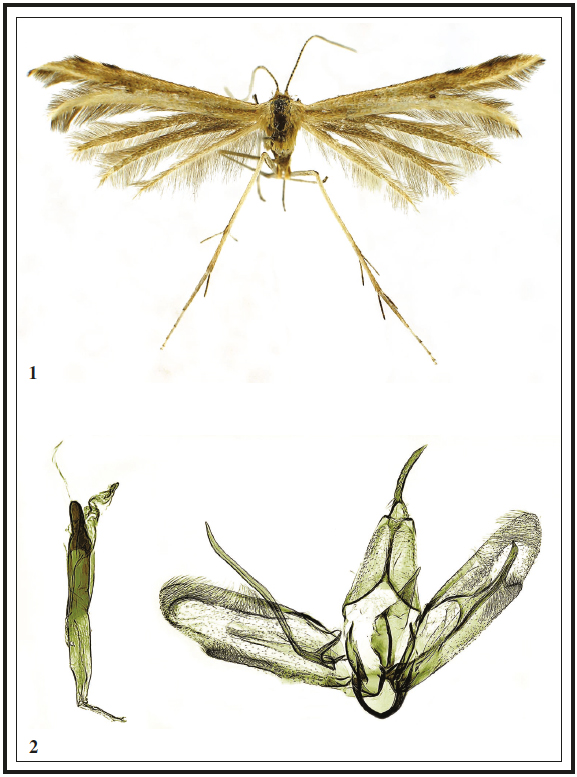

New species of plume moths from South Africa (Lepidoptera: Pterophoridae)
Nueva especie de terofórido de Sudáfrica (Lepidoptera: Pterophoridae)
New species of plume moths from South Africa (Lepidoptera: Pterophoridae)
SHILAP Revista de Lepidopterología, vol. 47, no. 186, 2019
Sociedad Hispano-Luso-Americana de Lepidopterología
Received: 31/08/2018
Accepted: 28/09/2018
Published: 30/06/2019
Abstract: The present article describes a new Pterophoridae species Hellinsia bidzilya Ustjuzhanin & Kovtunovich, sp. n., basing on the materials of Wolfram Mey (Berlin, Germany), Oleksiy Bidzilya (Kiev, Ukraine) and the collection of the Natural History Museum in Pretoria, the Republic of South Africa, and of the author’s collections. The data on its distribution and phenology are provided.
Keywords: Lepidoptera, Pterophoridae, new species, Republic of South Africa.
Resumen: El presente artículo describe una nueva especie de Pterophoridae Hellinsia bidzilya Ustjuzhanin & Kovtunovich, sp. n., basándose sobre el material de Wolfram Mey (Berlín, Alemania), Oleksiy Bidzilya (Kiev, Ucrania) y la colección del Natural History Museum en Pretoria, República de Sudáfrica y las colecciones de los autores. Se proporcionan los datos sobre su distribución y fenología.
Palabras clave: Lepidoptera, Pterophoridae, nueva especie, República de Sudáfrica.
Introduction
The genus Hellinsia Tutt, 1905 in South Africa is one of the largest concerning the species diversity. It includes over 15 species. Most of them prefer habitats with moderate moisture, more often in mountains and forest cenoses, they are much less common in deserts. In recent years, three species from South Africa have been described, one from Namibia (ARENBERGER, 2004), one from Lesotho (KOVTUNOVICH & USTJUZHANIN, 2011) and one from desert regions of West of South Africa (USTJUZHANIN & KOVTUNOVICH, 2016).
The type material is deposited in the museums: (MFN) Museum für Naturkunde (formerly Zoologisches Museum der Humboldt Universität), Berlin, Germany; (TMSA) Distong National Museum of Natural History, Pretoria, South Africa (formerly Transvaal Museum) and (CUK) Collection of P. Ustjuzhanin and V. Kovtunovich (Novosibirsk and Moscow, Russia).
Hellinsia bidzilya Ustjuzhanin & Kovtunovich, sp. n. (Figs 1-2)
Type material: Holotype ♂, (MFN 201701), South Africa, Eastern Cape, Graaff-Reinet, Asante Sana Game Farm, 10-XI-2012, W. Mey leg. Paratypes: 2 ♂♂, (MFN, CUK) South Africa, Eastern Cape, Graaff- Reinet, Petersburg, Sourkloof, 07-XI-2012, O. Bidzilya; 1 ♂, (TMSA) South Africa, Northern Cape, Nababieb, 29º 35’S, 17º 49’E, 30-VIII-02-IX-1962, Vari & Goode; 1 ♂, (TMSA) South Africa, Eastern Cape, Groor River Pass, 33º 57’S, 23º 34’E, 22-23-I-1955, A. J. T. Janse; 1 ♂, (CUK) South Africa, KwaZulu Natal, Weenen G. R., 28º 50’S, 29º 59’E, 950 m, 04-XII-2011, V. Kovtunovich, P. Ustjuzhanin.

Description: Head with pale brown setae, thorax and tegulae yellow grey. Labial palpus thin, straight, length equal to longitudinal eye diameter. Antenna pale brown. Wingspan 13-16 mm. Fore wing yellowish brown. Small dark brown spot in front of cleft. Elongated brown patches of scales along costal edge of fore wing distally. Second lobe noticeably paler than first, two small spots of brown scales on outer edge. Fringe inside cleft dark brown. Hind wing unicolor, brown grey, darker than fore wing, fringe between lobes dark grey. Hind leg yellow.
Male genitalia: Valva asymmetric. Thin, long harpe on left valva, slightly protruding beyond apex of valva. Right harpe slightly smaller than uncus, directed towards apex of valva, apically tapered. Sacculus wide, protruding beyond posterior edge of valva, with well-expressed rod-shaped harpe, slightly curved and sharp at end. Uncus thin, quite long. Saccus concave, arched. Anellus arms wide, of unequal length, left arm 2/3 of right arm, apex uncinate, right arm noticeably wider, tapered to apex. Phallus thin, almost straight, 1/2 of valva in length, slightly bent distally.
Female: Unknown.
Diagnosis: The new species is close to Hellinsia adumbratus (Walsingham, 1881), but these species differ in the genital structures. In the new species, the harpe on the left valva is long, slightly protruding beyond the apex of the valva; the harpe on the right valva is slightly smaller than the uncus and directed towards the apex of the valva, while in H. adumbratus, the harpe on the left valva does not reach the top of the valva, and the harpe on the right valva is 1/2 of the uncus and is directed perpendicularly to the outer edge of the valva.
Distribution: South Africa: Eastern Cape, Northern Cape, Kwa Zulu Natal.
Flight period: August- January.
Etymology: The species is named after the Ukrainian lepidopterologist, Oleksiy Bidzilya.
Acknowledgements
The authors are grateful to the curator of MFN, Dr Wolfram Mey (Berlin, Germany) and Dr Martin Krüger, curator of TMSA (Pretoria, RSA), for the possibility to work with collections. We also express our sincere gratitude to Oleksiy Bidzilya (Kiev, Ukraine) for the material provided for examination, and to Sergey Reshetnikov (Novosibirsk, Russia) for the photo of the adult.
BIBLIOGRAPHY
ARENBERGER, E., 2004.– Pterophoridae (Lepidoptera, Pterophoroidea).– In W. MEY (Ed.). The Lepidoptera of the Brandberg Massif in Namibia.– Esperiana Memoir, 1: 203-208.
KOVTUNOVICH, V. & USTJUZHANIN, P., 2011.– On the fauna of the plume moths (Lepidoptera: Pterophoridae) of Lesotho.– African Invertebrates, 52(1): 167-175.
USTJUZHANIN, P. & KOVTUNOVICH, V., 2016.– New species of South African plume moths (Lepidoptera: Pterophoridae).– Russian Entomological Journal, 25(2): 167-171.
Author notes
*Autor para la correspondencia / Corresponding author. E-mail: petrust@mail.ru